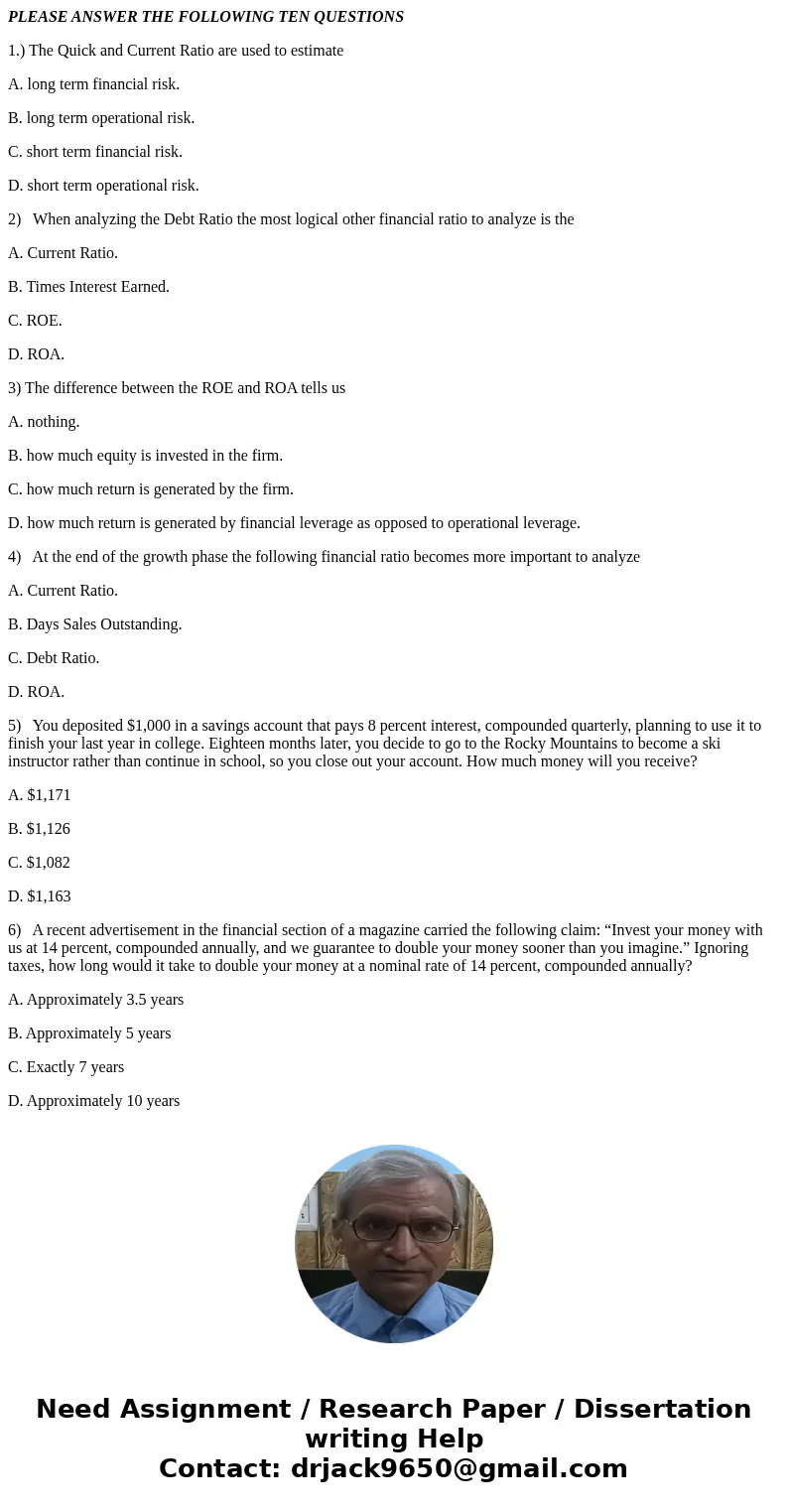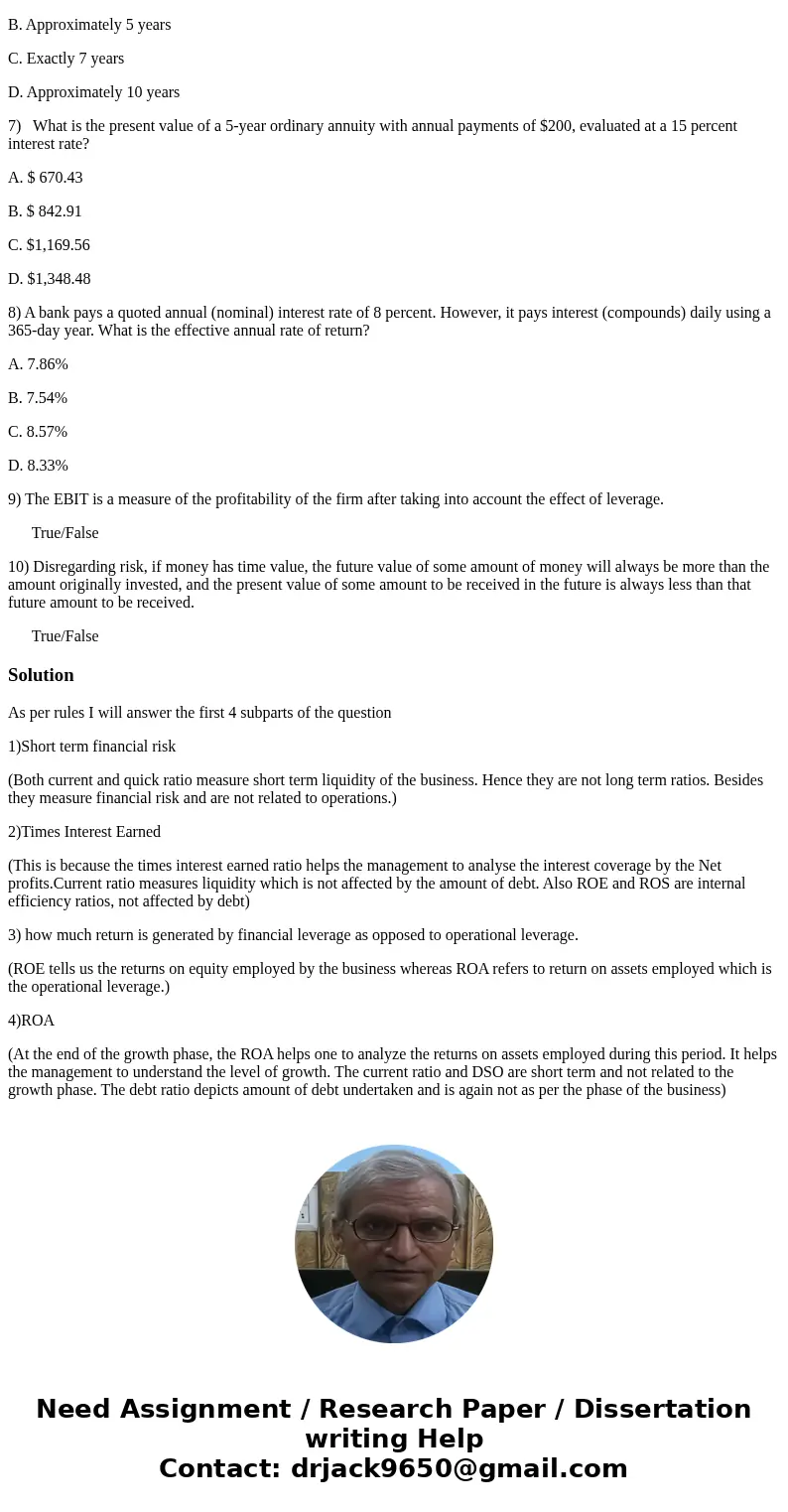PLEASE ANSWER THE FOLLOWING TEN QUESTIONS 1 The Quick and Cu
PLEASE ANSWER THE FOLLOWING TEN QUESTIONS
1.) The Quick and Current Ratio are used to estimate
A. long term financial risk.
B. long term operational risk.
C. short term financial risk.
D. short term operational risk.
2) When analyzing the Debt Ratio the most logical other financial ratio to analyze is the
A. Current Ratio.
B. Times Interest Earned.
C. ROE.
D. ROA.
3) The difference between the ROE and ROA tells us
A. nothing.
B. how much equity is invested in the firm.
C. how much return is generated by the firm.
D. how much return is generated by financial leverage as opposed to operational leverage.
4) At the end of the growth phase the following financial ratio becomes more important to analyze
A. Current Ratio.
B. Days Sales Outstanding.
C. Debt Ratio.
D. ROA.
5) You deposited $1,000 in a savings account that pays 8 percent interest, compounded quarterly, planning to use it to finish your last year in college. Eighteen months later, you decide to go to the Rocky Mountains to become a ski instructor rather than continue in school, so you close out your account. How much money will you receive?
A. $1,171
B. $1,126
C. $1,082
D. $1,163
6) A recent advertisement in the financial section of a magazine carried the following claim: “Invest your money with us at 14 percent, compounded annually, and we guarantee to double your money sooner than you imagine.” Ignoring taxes, how long would it take to double your money at a nominal rate of 14 percent, compounded annually?
A. Approximately 3.5 years
B. Approximately 5 years
C. Exactly 7 years
D. Approximately 10 years
7) What is the present value of a 5-year ordinary annuity with annual payments of $200, evaluated at a 15 percent interest rate?
A. $ 670.43
B. $ 842.91
C. $1,169.56
D. $1,348.48
8) A bank pays a quoted annual (nominal) interest rate of 8 percent. However, it pays interest (compounds) daily using a 365-day year. What is the effective annual rate of return?
A. 7.86%
B. 7.54%
C. 8.57%
D. 8.33%
9) The EBIT is a measure of the profitability of the firm after taking into account the effect of leverage.
True/False
10) Disregarding risk, if money has time value, the future value of some amount of money will always be more than the amount originally invested, and the present value of some amount to be received in the future is always less than that future amount to be received.
True/False
Solution
As per rules I will answer the first 4 subparts of the question
1)Short term financial risk
(Both current and quick ratio measure short term liquidity of the business. Hence they are not long term ratios. Besides they measure financial risk and are not related to operations.)
2)Times Interest Earned
(This is because the times interest earned ratio helps the management to analyse the interest coverage by the Net profits.Current ratio measures liquidity which is not affected by the amount of debt. Also ROE and ROS are internal efficiency ratios, not affected by debt)
3) how much return is generated by financial leverage as opposed to operational leverage.
(ROE tells us the returns on equity employed by the business whereas ROA refers to return on assets employed which is the operational leverage.)
4)ROA
(At the end of the growth phase, the ROA helps one to analyze the returns on assets employed during this period. It helps the management to understand the level of growth. The current ratio and DSO are short term and not related to the growth phase. The debt ratio depicts amount of debt undertaken and is again not as per the phase of the business)


 Homework Sourse
Homework Sourse